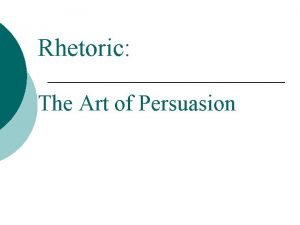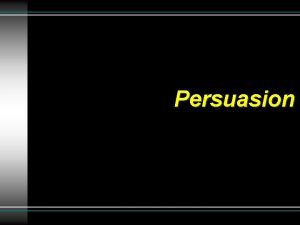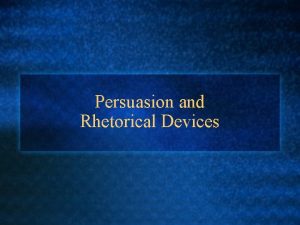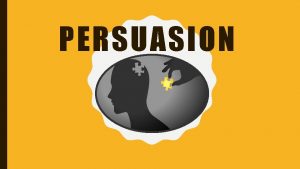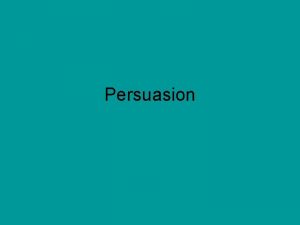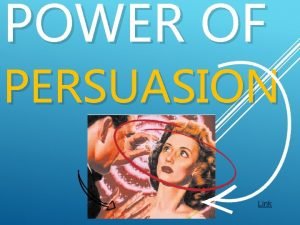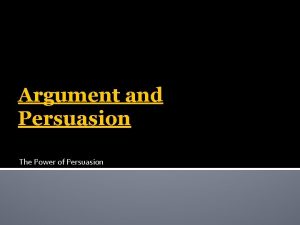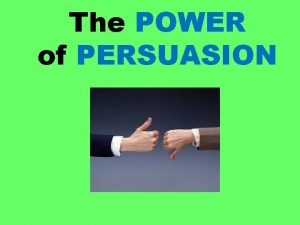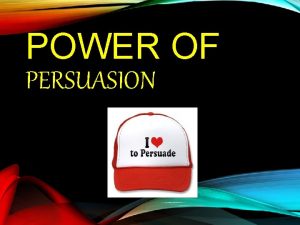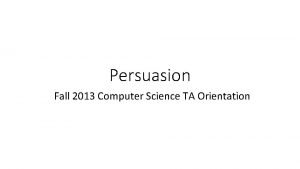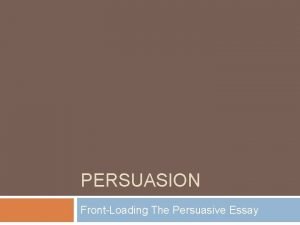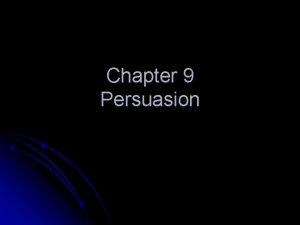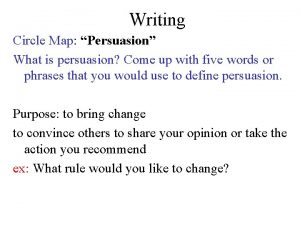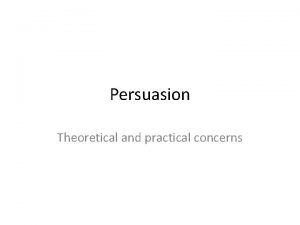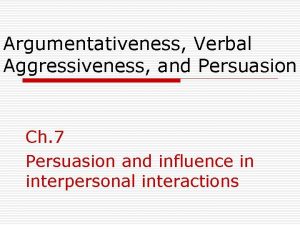The Power of Persuasion The Power of Persuasion






























- Slides: 30

The Power of Persuasion

The Power of Persuasion English Teacher: Suzi Plaut Math Teacher: Michele Durso Art Teacher: Bethe Levy Time Frame: 3 - 4 Weeks Grade Level: 6 th

Content Standards English Standards: (Language Arts MD Voluntary State Curriculum 2. 0 4, 2. 0 5, 4. 0 2) • Analyze important ideas and messages in informational texts • Analyze purposeful use of language • Compose oral, written, and visual presentations that express personal ideas, inform, and persuade Math Standards: (Bais Yaakov 6 th Grade Math Curriculum) • Demonstrate the ability to calculate unit prices of various items • Demonstrate the ability to estimate values such as unit prices. • Demonstrate the ability to construct a bar graph for the purposes of comparison using a medium of paper as well as Microsoft Excel Art Standards: (Art MD Voluntary State Curriculum 2. 0 4, 3. 0 2, 4. 0 1) • Apply problem solving strategies used among the arts to solve visual problems • Demonstrate ways the elements of art and principles of design are manipulated to communicate ideas • Analyze the ways the elements of art and principles of design contribute to aesthetic design http: //www. isbe. state. il. us/profprep/CASCDvr/htmls/Form. Info. htm

Concept Map

BT#1 – Emotional Connection All three integrated units begin with opening activities meant to assess current student knowledge and build an interest in the different subject matters (persuasive language, unit pricing, and visual advertisements). Throughout the unit, students clearly see the day-today relevance of the disparate skills they are learning. Arts and technology integration are threaded throughout the units in various ways. In addition, students have flexibility in some assignments to choose their method of assessment.

BT#1 – Emotional Connection English • Discuss prior knowledge of advertisements and review 6 + 1 Writing Traits Framework (this unit focuses on Word Choice; Ideas are secondary) • Students will create a constructed response (paragraph) about a time s/he persuaded her or his parents to have a privilege or gain a material item (responses shared on 2 nd day of unit) http: //www. 220 -electronics. com/tv/tvs. htm http: //www. mapds. com. au/newsletters/0807/Newsletter_18_July_2008. htm

BT#1 - Emotional Connection Math • Opening activity assesses students’ prior knowledge as well as introduces them to the importance of calculating unit pricing (BT#3) • Discussions about the importance of the topic and the relevance to students’ lives Art • Discuss prior knowledge of favorite snack food packaging and print advertisements • Later in the unit, students will create an appealing package for their choice of fruit or vegetable http: //know. triangle. com/node/11342

BT#2 – Physical Environment Arrange desks in small sections for group activities Rooms are comfortable and free of clutter English • Display teacher and student collected print advertisements • Have dictionaries and thesauri accessible for Word Choice activities NOT LIKE… Math • Display various store circulars around the room as well as a poster of the Food Pyramid • When completed, display students’ bar graphs • During final assessment, part of the classroom is transformed to look like a store http: //www. homeroomteacher. com/schooldeskchairs. html

BT#2 – Physical Environment Art • Food in the Arts will be displayed in the room as well as a poster of the Food Pyramid • Displays of students packaging of students favorite snacks http: //www. thinkstainless. com/portfolio_images/cheezit_package. jpg http: //dailyartmuse. com/wp-content/uploads/2009/01/dolack_dots. jpg http: //www. guy-sports. com/fun_pictures/art_with_food. jpg http: //www. artrepublic. com/attachments/image/695/10695. jpeg

BT#3 – Concept Map

BT#3 – Introductory “Big Picture” Activity English • Students will create a constructed response (paragraph) about a time s/he persuades her or his parents to have a privilege, take responsibility or gain a material item • Have students identify commonly known advertisement campaigns/slogans

BT#3 – “Big Picture” Activity Word Choice is the use of rich, colorful, precise language that communicates not just in a functional way, but in a way that moves and enlightens the reader. In descriptive writing, strong word choice resulting in imagery, especially sensory, show-me writing, clarifies and expands ideas. In persuasive writing, purposeful word choice moves the reader to a new vision of ideas. In all modes of writing figurative language such as metaphors, similes and analogies articulate, enhance, and enrich the content. Strong word choice is characterized not so much by an exceptional vocabulary chosen to impress the reader, but more by the skill to use everyday words well. http: //www. thetraits. org/definitions. php

BT#3 – Introductory “Big Picture” Activity Math • Connect students to the importance of understanding unit pricing through an interactive activity where students are presented with two sizes of common household items (e. g. tuna fish, mayonnaise, soda, etc. ) and the corresponding price of each and asked to determine which is the better deal • Have students discuss in small groups how they would actually determine which item is the “real” better deal; discuss “unit pricing” terminology Art • Favorite Packaged Snack Foods and Food in Art will be collected and displayed on wall • Students will discuss how they feel when they see popular ads or appealing images and why they think they feel that way http: //latimesblogs. latimes. com/greenspace/2009/01/california-atto. html

BT#4 – Mastery Activities English • Using school lunch menu, students will create more appetizing descriptions (focusing on word choice) • Throughout the unit, encourage students to share experiences of persuasive techniques they encounter in their life experiences • Students will share a description of their favorite food experience using figurative language and descriptive words without naming the food; peers will “guess” the food • In a partner activity, students will use their parent persuasive constructed response from Day 1 and create a realistic dialogue between a child and a parent based on the topic discussed; focus on word choice and persuasive techniques (and body language); some scenes will be acted out • In small groups, create persuasive topic sentences (theses) for 6 different topics: bike helmets, bed time, movie rating system, the age kids should be able to get their own cell phone, middle school start times, and female players in the NFL. • Students will rewrite a Dr. Seuss book for a middle school audience without rhymes and with appropriate word choice while still maintaining the message of the story

BT#4 – Mastery Activities “How do I know which word to use? ” • Know the difference between connotation and denotation. – Connotation is the feeling a word gives a reader. • Ex. boney vs. slender – Denotation is the actual dictionary definition of the word. • Use figurative language to help you describe something or someone ordinary. – Similes, metaphors, personification, and alliteration • Identify your topic, audience, and purpose for writing – Avoid slang unless it is a character’s voice. – Use content specific vocabulary. – Use persuasive language when appropriate. From Howard County Middle School Writing Stylebook

BT#4 – Mastery Activities “When I’m writing dialogue, what other words can I use besides ‘said’? ” added agreed babbled boasted commanded claimed decided explained estimated grunted insisted instructed lectured mentioned mumbled nagged objected pleaded reassured requested scolded shrieked stammered taunted urged uttered vowed warned wailed whispered

BT#4 – Mastery Activities “What are overused words? ” a lot bad good big cool cute fun great very interesting pretty sad said little got run tell stuff take things walk sit Warning: When using a thesaurus, DON’T OVERDO IT! Readers can tell if a word is out of place, so use words that you own and that fit your style!

BT#4 – Mastery Activities In groups, create a Persuasive Topic Sentence for each Issue: 1. 2. 3. 4. 5. 6. Bike helmet laws Movie rating system Bed time for 7 th graders Women in the NFL Start times of Middle School Age kids should have their own cell phones http: //chinaoutdoorequipment. blogspot. com/2008/02/bike-helmet-h 003. html

BT#4 – Mastery Activities Math • In small groups, students look at local store circulars provided by the teacher and “comparison shop, ” noting the various unit prices of different sizes and brands of items • On the SMART Board, teacher and students will use Microsoft Excel to create a bar graph together comparing the prices of various brands and sizes • Group discussion of bar graphs: How do they help us compare items quickly? What are other methods of visually presenting information for purposes of comparison? • Class debate on estimation: Why is this an important supermarket tool? “Why can’t we just use a calculator? ? ” http: //juliazanglcolby. wikispaces. com/SMARTBoard

BT#4 – Mastery Activities Art • “Clementine Experience” – the class creates a graphic organizer modeling descriptive language • “Draw What You Smell” – students choose 3 of 15 foods hidden under cones and draw what they smell but cannot see • Track one day’s food intake and correlate to the food pyramid • Bring in packaging of a snack food, find its spot in the food pyramid, and identify the appeal of packaging http: //www. lesliebeck. com/recipe_detail. php? id=797

BT#4 – Mastery Activities Art • Compare and contrast the packaging of Oreo cookies in the 50’s to present-day packaging. Guiding Questions: How much does the packaging matter? Where does your snack show up in the food pyramid? Why aren’t major food pyramid foods packaged like snacks? What is done with the package after the product is finished? http: //www 2. canada. com/topics/lifestyle/holidayguide 2007/create/cooking. html

BT#5 – Extension & Application English • Students will write a persuasive speech for their peers convincing them to buy his or her chosen fruit or vegetable • Students will create an appealing print advertisement for his or her chosen fruit or vegetable using knowledge of word choice • At least a week prior to final speeches, peers give feedback to each other on written persuasive speeches, focusing on effective argument and word choice (rubric provided)

BT#5 – Extension & Application Math • Students individually create a scrapbook listing unit prices for like items with different brands and sizes (research done as homework) • Students use daily food intake recorded for art class and visually depict how their food intake corresponds to the • Have students recommended amounts of each food research online if it group (bar graphs will be completed with is mandatory in either graph paper or software such as their state for Microsoft Excel) merchants to post unit prices for all items http: //www. ag. ndsu. edu/pubs/yf/foods/he 516 w. htm

BT#5 – Extension & Application Art • Choose from 10 snack packages provided and compare and contrast three to the packaging of a bag of carrots using a Venn Diagram • Packaging Project: Students choose a specific fruit or vegetable from a basket, and design and create an appealing package for their item using the design elements of Color, Shape, Graphics, Texture, and Packaging as Content

BT#5 – Extension & Application Art, Cont. • Correlate the carrots and the 3 chosen snack foods to the food pyramid: Which foods would children choose? Why? How can you make carrots more appealing? What are the element designs that appeal to children? What can the children do with the packaging after product is consumed? (Example: Cheezit Package) http: //www. thinkstainless. com/portfolio_images/cheezit_package. jpg http: //www. idsgn. org/images/ritz-and-oreo-go-retro/oreo_before_after. jpg

BT#6 – Evaluation English • Use classroom resources (dictionary and thesauri) as well as peer and teacher feedback to revise favorite food descriptive writing • Present persuasive speech to peers and teacher • Rubric is used to evaluate student essays • Students write PQP (Praise Question Polish) as their peers share persuasive speeches http: //dailymobile. se/2008/07/page/6/

BT#6 – Evaluation Writing to Persuade Rubric Score Point 4 • I have taken a clear stand on an issue and I fully support it with appropriate personal or factual information. • I have chosen numerous specific details that more than adequately support my stand. • I have an organization that is logical and does not jump around. • I understand the type of audience I am writing for and I use language and arguments that they will understand. • I make good language choices to help influence the reader to agree with me. Note: This rubric has been modified for use with 6 th graders. It is to be considered "kid language" For comments and inquiries, send email to: Cam Miller Curriculum Planner Berlin Middle School Worcester County

BT#6 – Evaluation Math • Evaluate students’ scrapbooks and graphs for neatness and accuracy using a rubric • On the last day of the unit, an interactive assessment will have students act and feel as if they are shoppers trying to find the best deal in a store without unit prices listed. Students will choose which items to buy based on calculating the unit price as well as “speed shop” through one section using estimation http: //spreadsheets. about. com/od/excelcharts/ss/bar_graph_6. htm

BT#6 – Evaluation Art • Portfolio Assessment and Reflection of various activities • Presentation of fruit or vegetable packaging to class; rubric is used to assign grade At the conclusion of the unit, each student will give anonymous feedback to teachers about how to improve this unit for future years… for example, I liked… I did not like. . . I wish I had more time to…I wish my art teacher… I wish my English teacher… I wish my math teacher…

Concept Map
 Persuasive leverage
Persuasive leverage Active power reactive power apparent power
Active power reactive power apparent power Thế nào là hệ số cao nhất
Thế nào là hệ số cao nhất Hệ hô hấp
Hệ hô hấp Bảng số nguyên tố lớn hơn 1000
Bảng số nguyên tố lớn hơn 1000 đặc điểm cơ thể của người tối cổ
đặc điểm cơ thể của người tối cổ Mật thư tọa độ 5x5
Mật thư tọa độ 5x5 Các châu lục và đại dương trên thế giới
Các châu lục và đại dương trên thế giới Thang điểm glasgow
Thang điểm glasgow ưu thế lai là gì
ưu thế lai là gì Thẻ vin
Thẻ vin Tư thế ngồi viết
Tư thế ngồi viết Cái miệng bé xinh thế chỉ nói điều hay thôi
Cái miệng bé xinh thế chỉ nói điều hay thôi Các châu lục và đại dương trên thế giới
Các châu lục và đại dương trên thế giới Từ ngữ thể hiện lòng nhân hậu
Từ ngữ thể hiện lòng nhân hậu Bổ thể
Bổ thể Tư thế ngồi viết
Tư thế ngồi viết Thế nào là giọng cùng tên? *
Thế nào là giọng cùng tên? * Thể thơ truyền thống
Thể thơ truyền thống Chúa yêu trần thế alleluia
Chúa yêu trần thế alleluia Sự nuôi và dạy con của hươu
Sự nuôi và dạy con của hươu đại từ thay thế
đại từ thay thế Diễn thế sinh thái là
Diễn thế sinh thái là Vẽ hình chiếu vuông góc của vật thể sau
Vẽ hình chiếu vuông góc của vật thể sau 101012 bằng
101012 bằng Công thức tính thế năng
Công thức tính thế năng Thế nào là mạng điện lắp đặt kiểu nổi
Thế nào là mạng điện lắp đặt kiểu nổi Tỉ lệ cơ thể trẻ em
Tỉ lệ cơ thể trẻ em Lời thề hippocrates
Lời thề hippocrates Vẽ hình chiếu đứng bằng cạnh của vật thể
Vẽ hình chiếu đứng bằng cạnh của vật thể






























